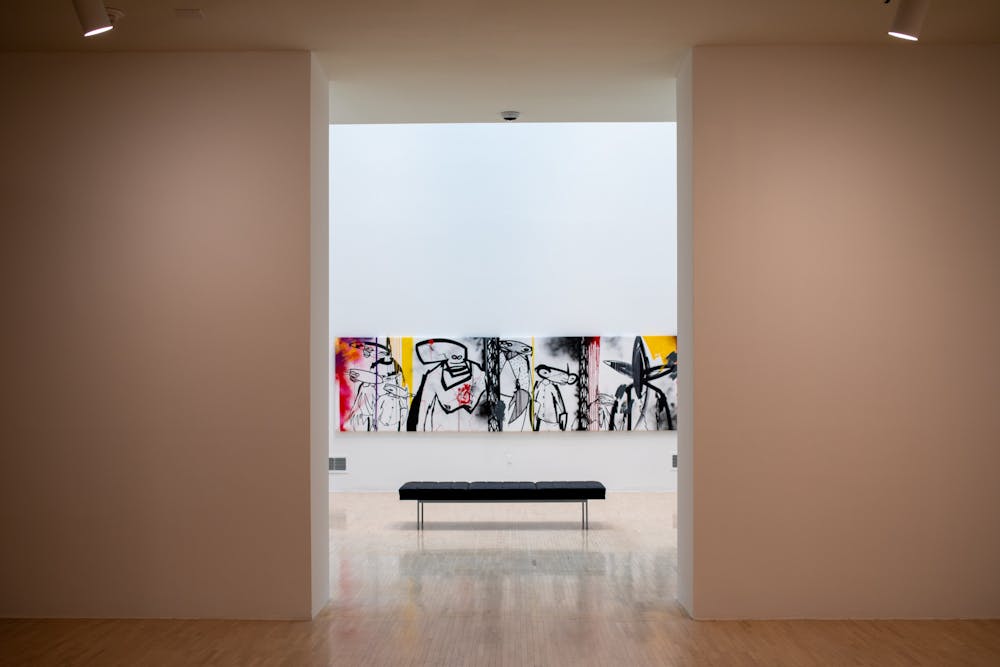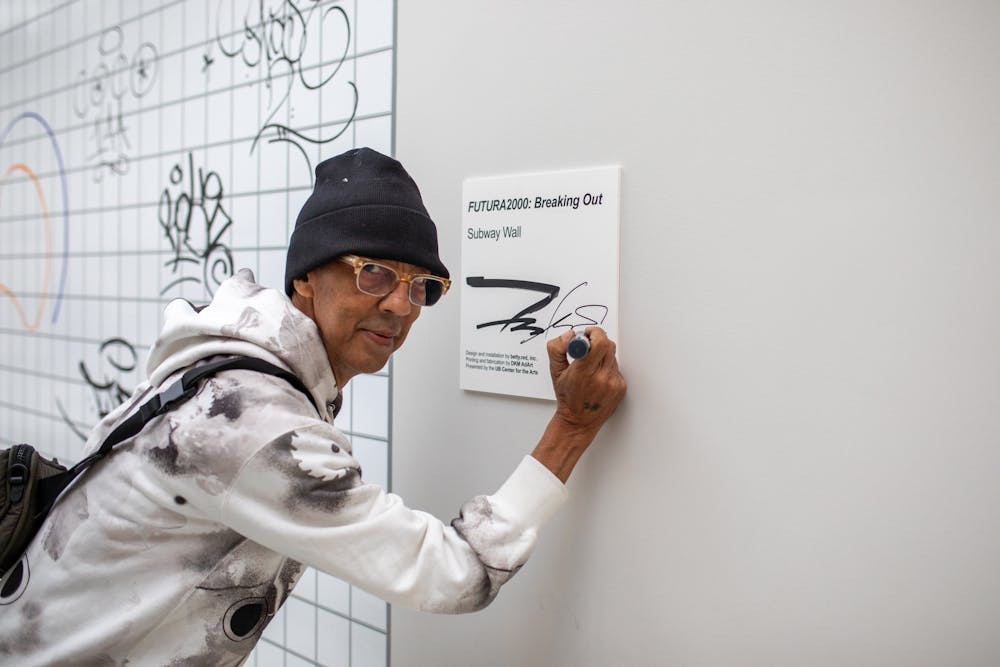In the 1970s, young artists took hold of the aerosol can and sought the public canvases of trains and buildings in NYC as an outlet for self-expression. The thrill of the movement helped to alleviate the identity crisis of 15-year-old Leonard McGurr after his mom disclosed to him that was adopted.
Between McGurr’s sporadic stints as the artist, FUTURA2000, he birthed the abstraction of graffiti art — a feat that the UB Galleries is immortalizing 40 years later in the artist’s first retrospective exhibition, FUTURA2000: Breaking Out.
Just through the entrance to UB’s Anderson Gallery, a gold-framed photograph of a moving train enveloped in spray paint hangs against the backdrop of a modern New York City subway map. To the right of the photograph, a screen plays a 1980 CBS special on graffiti featuring FUTURA and other writers (graffiti artists). It was FUTURA’s curiosity about “the absence of those letter structures, beautiful color fields and abstract realms” that prompted the historical “Break” train. His piece was the first time that a writer had released spray paint from the confines of graffiti lettering and realized the art form without calligraphy.
The photograph by Martha Cooper garnered enough attention for FUTURA to depart from the public walls of the city and into the private walls of galleries, after returning from his four-year service in the Navy. His work was exhibited for the first time at the Long Island City’s Museum of Modern Art (MoMA) PS1. The 1981 exhibition, New York/New Wave, curated by Diego Cortez, featured Andy Warhol, Jean Michel Basquiat and Keith Haring.
“Martha’s photograph of my train, which is remarkable — if she doesn’t photograph it, what do I have to show or leverage from such a long time ago?” FUTURA said in an interview with The Spectrum.

Throughout the gallery, motifs of atoms, gears, circular saw blades, aliens and cranes prevail from their futuristic implications for the artist — implications that were wholly derived from personal experiences.
In the ‘70s, the visuals of atoms on Johnson & Johnson’s Future Floor Wax product packaging enraptured FUTURA. The emergence of nuclear power at the time and the centrality of the nucleus “fascinated” him hence his continual return to the symbol.
In 1981, on his first trip to Paris, he witnessed the La Défense in its construction period, where an image of 12 cranes overtaking the sky reminded him of All Terrain walkers from “Star Wars.” The novelty of the sight primed his association of cranes with change, building and development.
This recurring image of a crane-filled landscape was unimaginable for New Yorkers back then, but that hasn’t deterred the prominence of it now. FUTURA’s artistry signals us to consider his canvases as a portal to the future.
In “Untitled” (1984), an unexpected shape accompanies FUTURA’s established system of imagery. The shape of an arrow vector may remind us of modern navigation systems like Google Maps or Waze, but this association was less ubiquitous at the time, as the Global Position System (GPS) was first developed in 1973. According to FUTURA, the appearance of the “chevron imagery” is a nod to the logo of his military squadron. Though the sign elicits another connection to the Navy where advancing informational technologies like the GPS is of the utmost priority.
An extremely notable development in FUTURA’s work is the thin, fine lines he was able to create by inverting the aerosol can and painting canvases on the floor to tactically control the line’s density.
On the second floor of the Anderson Gallery, FUTURA’s prolific impact in the fashion, music and cultural industries are highlighted by archives of his collaborations with brands like Virgil Abloh’s Off-White, Supreme and KAWS.
The nearest wall to the right floor’s entrance is lined with album covers that FUTURA designed for the English ‘70s rock band, the Clash. In recognition of his artistry, FUTURA joined the band on their 1981 Combat Rock European tour, where he painted large-scale backdrops on stage during their performances.
FUTURA was also integral to the emergence of hip-hop culture in the ‘90s. He and 50 of his fellow writers, including Fab 5 Freddy and Dondi, embarked on the New York City Rap Tour in Europe, introducing hip-hop culture to France.
Earlier this year, FUTURA and rapper Nas worked together to produce a vinyl record of 12 hip-hop defining tracks to celebrate the 50th anniversary of hip-hop for 12on12, a collaboration that is on display at the Anderson Gallery.
At the Center For the Arts (CFA) Gallery, the floors are not only inhabited by “recent” pieces but by a series of paintings that FUTURA finished this past summer based on 10 neighborhoods in Buffalo.
When FUTURA visited the CFA about a year ago, UB Art Galleries director Robert Scalise proposed that they place his “recent” pieces in the CFA gallery.
“No man, let’s make all new work,” FUTURA said, according to Scalise.
Scalise and the gallery’s team took FUTURA around the city where FUTURA was “really bonding with the city” and making parallels between New York City and Buffalo. The parallel between his origins in Brooklyn’s Riverside and Buffalo’s Riverside felt strong enough for FUTURA to name the CFA exhibit “From Brooklyn to Buffalo.”

In furthering his connection and access to the Buffalo public, FUTURA partnered with The Buffalo AKG Art Museum Public Art Initiative to produce a mural called “Bradford Reds” on 712 Elmwood Ave. To commemorate this retrospective exhibition, FUTURA has also collaborated with New Era Cap and Oxford Pennant to create a limited edition cap and merchandise.
“The name of the exhibition here, ‘Breaking Out,’ it’s kind of a return to that theme of not breaking tradition or whatever — not breaking windows, but maybe breaking through, in some ways,” FUTURA said. “It doesn’t have to be negative, but breaking could be positive: you finally made it,”
The exhibition is on view at the UB Anderson and CFA Galleries until Feb. 11, 2024.
Tenzin Wodhean is an arts editor and can be reached at tenzin.wodhean@ubspectrum.com





